Visitor Attraction Management
VerifiedAdded on 2023/01/19
|11
|3775
|87
AI Summary
This report discusses the various classifications of visitor attractions, their importance and impact on the economy, the need and motivation behind different types of attractions, and the positive and negative factors affecting them. It also includes a feasibility study for visitor attractions. The case study focuses on France and its attractions such as the Eiffel Tower, Disneyland Paris, and Louvre Museum.
Contribute Materials
Your contribution can guide someone’s learning journey. Share your
documents today.

VISITOR ATTRACTION
MANAGEMENT
MANAGEMENT
Secure Best Marks with AI Grader
Need help grading? Try our AI Grader for instant feedback on your assignments.
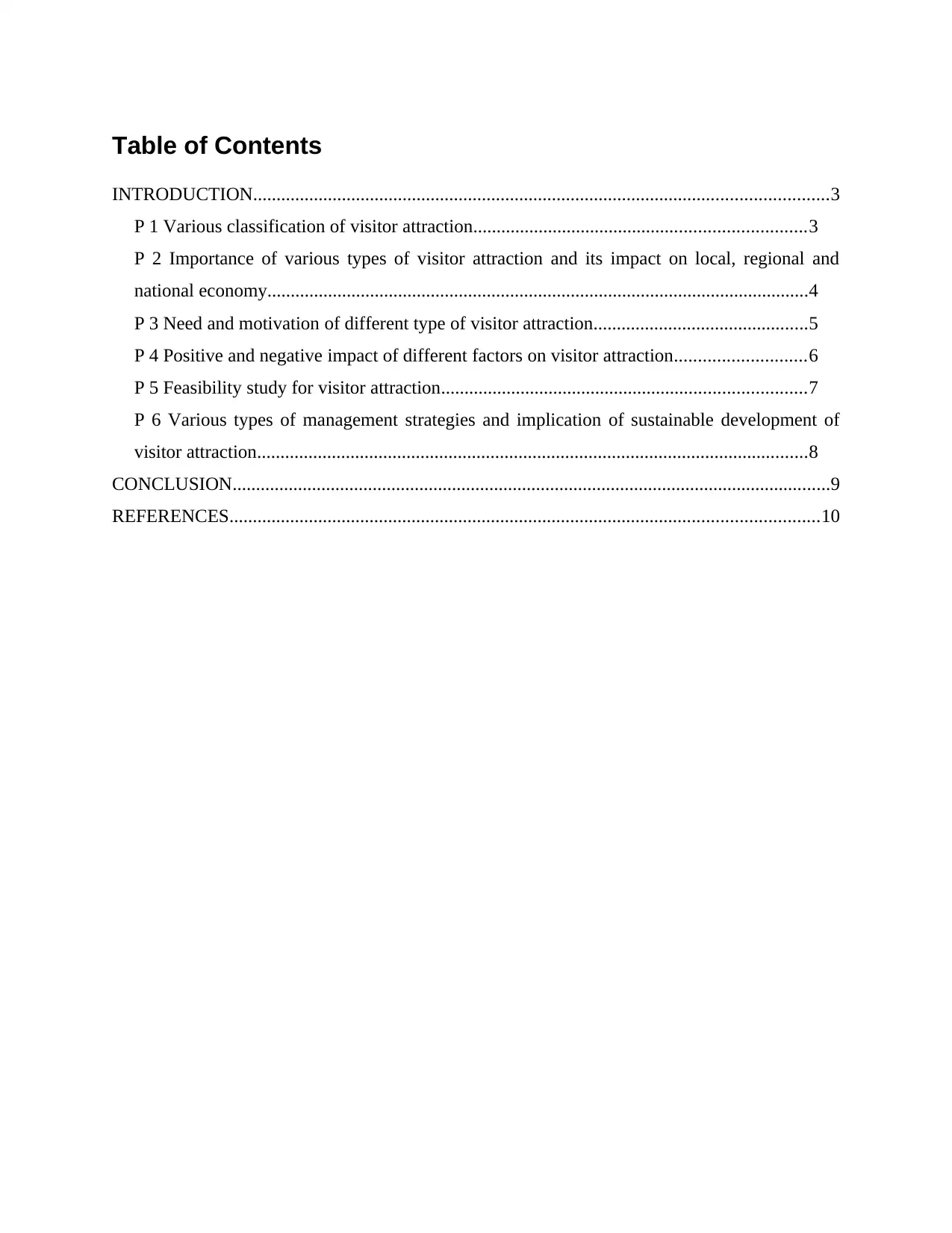
Table of Contents
INTRODUCTION...........................................................................................................................3
P 1 Various classification of visitor attraction.......................................................................3
P 2 Importance of various types of visitor attraction and its impact on local, regional and
national economy....................................................................................................................4
P 3 Need and motivation of different type of visitor attraction..............................................5
P 4 Positive and negative impact of different factors on visitor attraction............................6
P 5 Feasibility study for visitor attraction..............................................................................7
P 6 Various types of management strategies and implication of sustainable development of
visitor attraction......................................................................................................................8
CONCLUSION................................................................................................................................9
REFERENCES..............................................................................................................................10
INTRODUCTION...........................................................................................................................3
P 1 Various classification of visitor attraction.......................................................................3
P 2 Importance of various types of visitor attraction and its impact on local, regional and
national economy....................................................................................................................4
P 3 Need and motivation of different type of visitor attraction..............................................5
P 4 Positive and negative impact of different factors on visitor attraction............................6
P 5 Feasibility study for visitor attraction..............................................................................7
P 6 Various types of management strategies and implication of sustainable development of
visitor attraction......................................................................................................................8
CONCLUSION................................................................................................................................9
REFERENCES..............................................................................................................................10
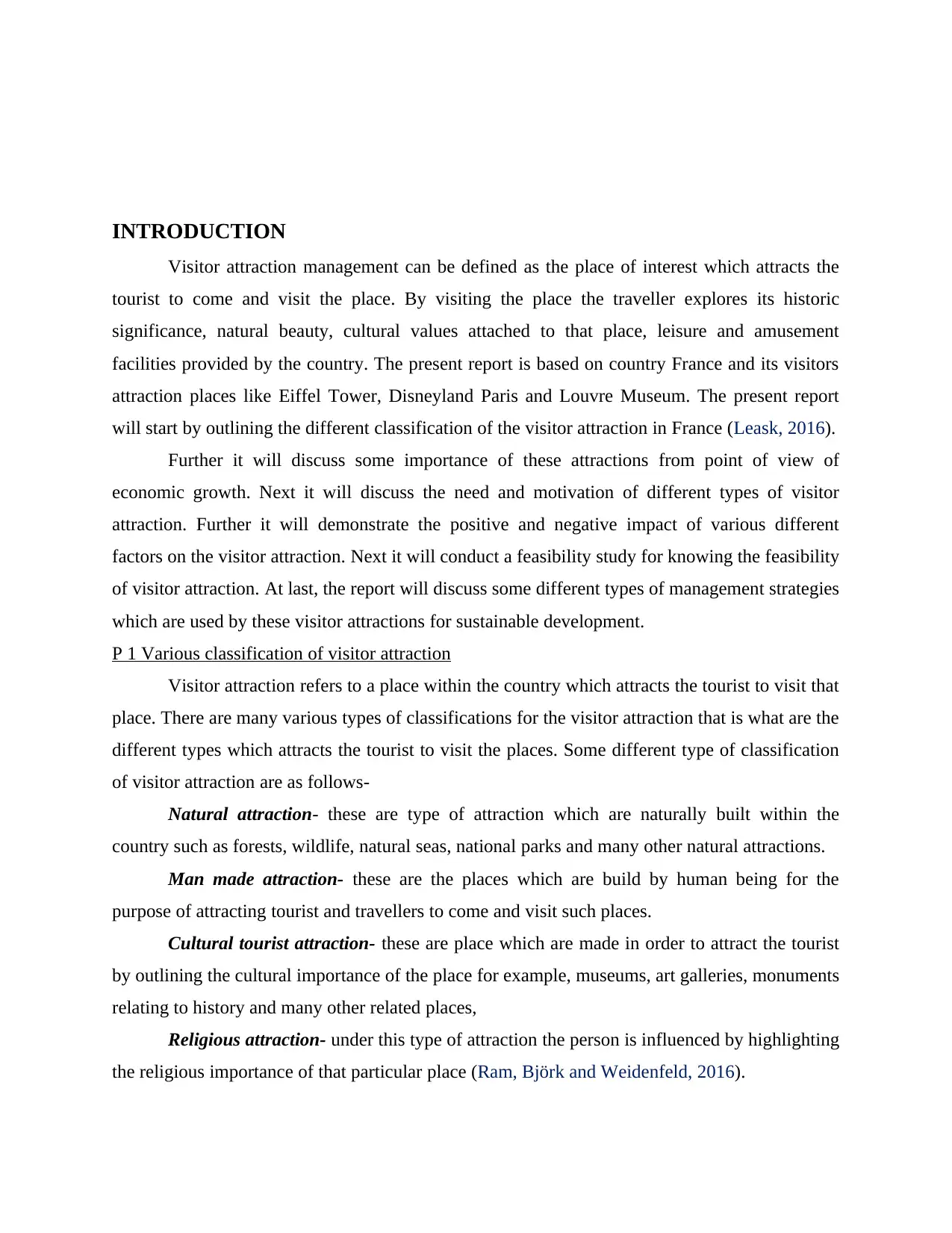
INTRODUCTION
Visitor attraction management can be defined as the place of interest which attracts the
tourist to come and visit the place. By visiting the place the traveller explores its historic
significance, natural beauty, cultural values attached to that place, leisure and amusement
facilities provided by the country. The present report is based on country France and its visitors
attraction places like Eiffel Tower, Disneyland Paris and Louvre Museum. The present report
will start by outlining the different classification of the visitor attraction in France (Leask, 2016).
Further it will discuss some importance of these attractions from point of view of
economic growth. Next it will discuss the need and motivation of different types of visitor
attraction. Further it will demonstrate the positive and negative impact of various different
factors on the visitor attraction. Next it will conduct a feasibility study for knowing the feasibility
of visitor attraction. At last, the report will discuss some different types of management strategies
which are used by these visitor attractions for sustainable development.
P 1 Various classification of visitor attraction
Visitor attraction refers to a place within the country which attracts the tourist to visit that
place. There are many various types of classifications for the visitor attraction that is what are the
different types which attracts the tourist to visit the places. Some different type of classification
of visitor attraction are as follows-
Natural attraction- these are type of attraction which are naturally built within the
country such as forests, wildlife, natural seas, national parks and many other natural attractions.
Man made attraction- these are the places which are build by human being for the
purpose of attracting tourist and travellers to come and visit such places.
Cultural tourist attraction- these are place which are made in order to attract the tourist
by outlining the cultural importance of the place for example, museums, art galleries, monuments
relating to history and many other related places,
Religious attraction- under this type of attraction the person is influenced by highlighting
the religious importance of that particular place (Ram, Björk and Weidenfeld, 2016).
Visitor attraction management can be defined as the place of interest which attracts the
tourist to come and visit the place. By visiting the place the traveller explores its historic
significance, natural beauty, cultural values attached to that place, leisure and amusement
facilities provided by the country. The present report is based on country France and its visitors
attraction places like Eiffel Tower, Disneyland Paris and Louvre Museum. The present report
will start by outlining the different classification of the visitor attraction in France (Leask, 2016).
Further it will discuss some importance of these attractions from point of view of
economic growth. Next it will discuss the need and motivation of different types of visitor
attraction. Further it will demonstrate the positive and negative impact of various different
factors on the visitor attraction. Next it will conduct a feasibility study for knowing the feasibility
of visitor attraction. At last, the report will discuss some different types of management strategies
which are used by these visitor attractions for sustainable development.
P 1 Various classification of visitor attraction
Visitor attraction refers to a place within the country which attracts the tourist to visit that
place. There are many various types of classifications for the visitor attraction that is what are the
different types which attracts the tourist to visit the places. Some different type of classification
of visitor attraction are as follows-
Natural attraction- these are type of attraction which are naturally built within the
country such as forests, wildlife, natural seas, national parks and many other natural attractions.
Man made attraction- these are the places which are build by human being for the
purpose of attracting tourist and travellers to come and visit such places.
Cultural tourist attraction- these are place which are made in order to attract the tourist
by outlining the cultural importance of the place for example, museums, art galleries, monuments
relating to history and many other related places,
Religious attraction- under this type of attraction the person is influenced by highlighting
the religious importance of that particular place (Ram, Björk and Weidenfeld, 2016).
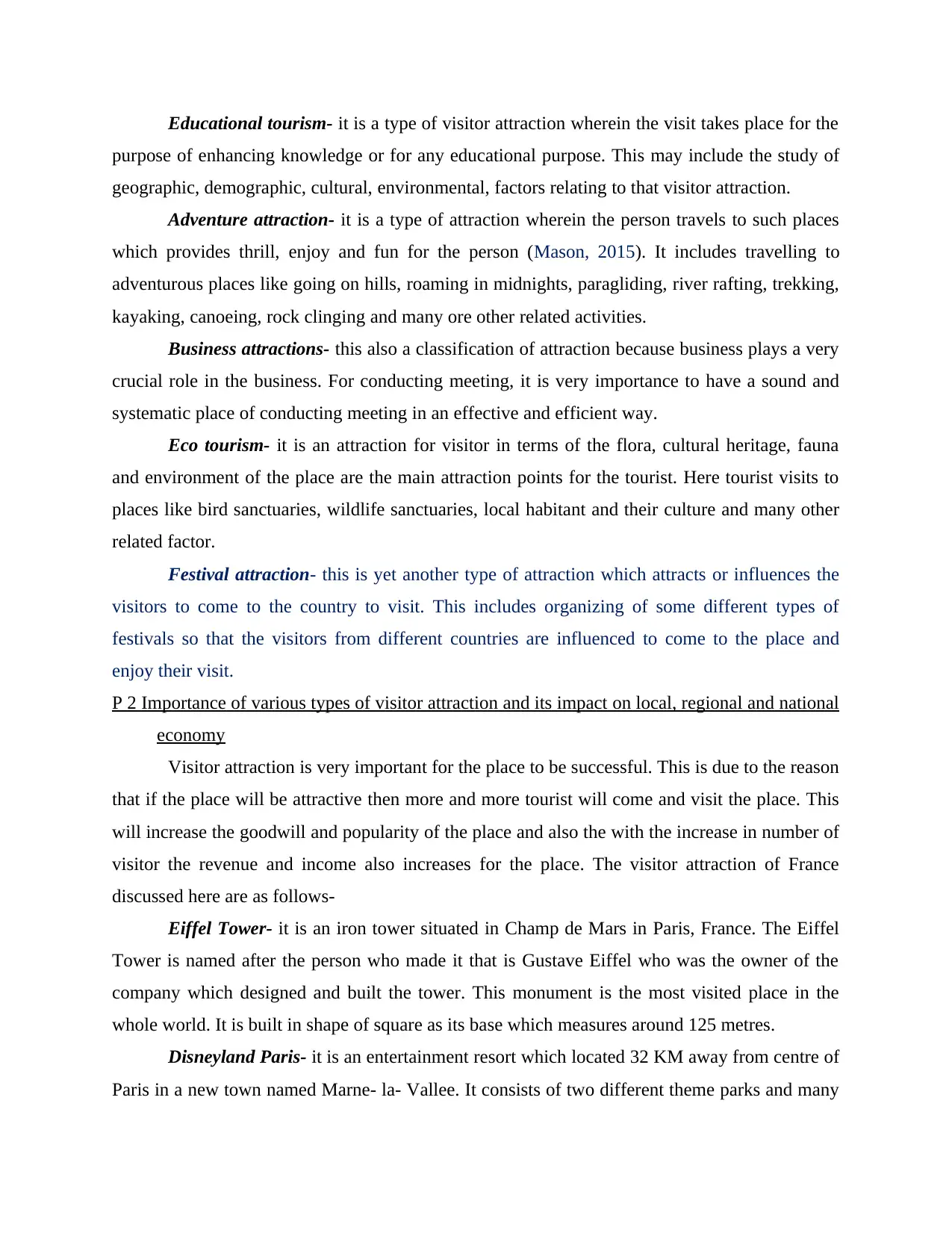
Educational tourism- it is a type of visitor attraction wherein the visit takes place for the
purpose of enhancing knowledge or for any educational purpose. This may include the study of
geographic, demographic, cultural, environmental, factors relating to that visitor attraction.
Adventure attraction- it is a type of attraction wherein the person travels to such places
which provides thrill, enjoy and fun for the person (Mason, 2015). It includes travelling to
adventurous places like going on hills, roaming in midnights, paragliding, river rafting, trekking,
kayaking, canoeing, rock clinging and many ore other related activities.
Business attractions- this also a classification of attraction because business plays a very
crucial role in the business. For conducting meeting, it is very importance to have a sound and
systematic place of conducting meeting in an effective and efficient way.
Eco tourism- it is an attraction for visitor in terms of the flora, cultural heritage, fauna
and environment of the place are the main attraction points for the tourist. Here tourist visits to
places like bird sanctuaries, wildlife sanctuaries, local habitant and their culture and many other
related factor.
Festival attraction- this is yet another type of attraction which attracts or influences the
visitors to come to the country to visit. This includes organizing of some different types of
festivals so that the visitors from different countries are influenced to come to the place and
enjoy their visit.
P 2 Importance of various types of visitor attraction and its impact on local, regional and national
economy
Visitor attraction is very important for the place to be successful. This is due to the reason
that if the place will be attractive then more and more tourist will come and visit the place. This
will increase the goodwill and popularity of the place and also the with the increase in number of
visitor the revenue and income also increases for the place. The visitor attraction of France
discussed here are as follows-
Eiffel Tower- it is an iron tower situated in Champ de Mars in Paris, France. The Eiffel
Tower is named after the person who made it that is Gustave Eiffel who was the owner of the
company which designed and built the tower. This monument is the most visited place in the
whole world. It is built in shape of square as its base which measures around 125 metres.
Disneyland Paris- it is an entertainment resort which located 32 KM away from centre of
Paris in a new town named Marne- la- Vallee. It consists of two different theme parks and many
purpose of enhancing knowledge or for any educational purpose. This may include the study of
geographic, demographic, cultural, environmental, factors relating to that visitor attraction.
Adventure attraction- it is a type of attraction wherein the person travels to such places
which provides thrill, enjoy and fun for the person (Mason, 2015). It includes travelling to
adventurous places like going on hills, roaming in midnights, paragliding, river rafting, trekking,
kayaking, canoeing, rock clinging and many ore other related activities.
Business attractions- this also a classification of attraction because business plays a very
crucial role in the business. For conducting meeting, it is very importance to have a sound and
systematic place of conducting meeting in an effective and efficient way.
Eco tourism- it is an attraction for visitor in terms of the flora, cultural heritage, fauna
and environment of the place are the main attraction points for the tourist. Here tourist visits to
places like bird sanctuaries, wildlife sanctuaries, local habitant and their culture and many other
related factor.
Festival attraction- this is yet another type of attraction which attracts or influences the
visitors to come to the country to visit. This includes organizing of some different types of
festivals so that the visitors from different countries are influenced to come to the place and
enjoy their visit.
P 2 Importance of various types of visitor attraction and its impact on local, regional and national
economy
Visitor attraction is very important for the place to be successful. This is due to the reason
that if the place will be attractive then more and more tourist will come and visit the place. This
will increase the goodwill and popularity of the place and also the with the increase in number of
visitor the revenue and income also increases for the place. The visitor attraction of France
discussed here are as follows-
Eiffel Tower- it is an iron tower situated in Champ de Mars in Paris, France. The Eiffel
Tower is named after the person who made it that is Gustave Eiffel who was the owner of the
company which designed and built the tower. This monument is the most visited place in the
whole world. It is built in shape of square as its base which measures around 125 metres.
Disneyland Paris- it is an entertainment resort which located 32 KM away from centre of
Paris in a new town named Marne- la- Vallee. It consists of two different theme parks and many
Secure Best Marks with AI Grader
Need help grading? Try our AI Grader for instant feedback on your assignments.
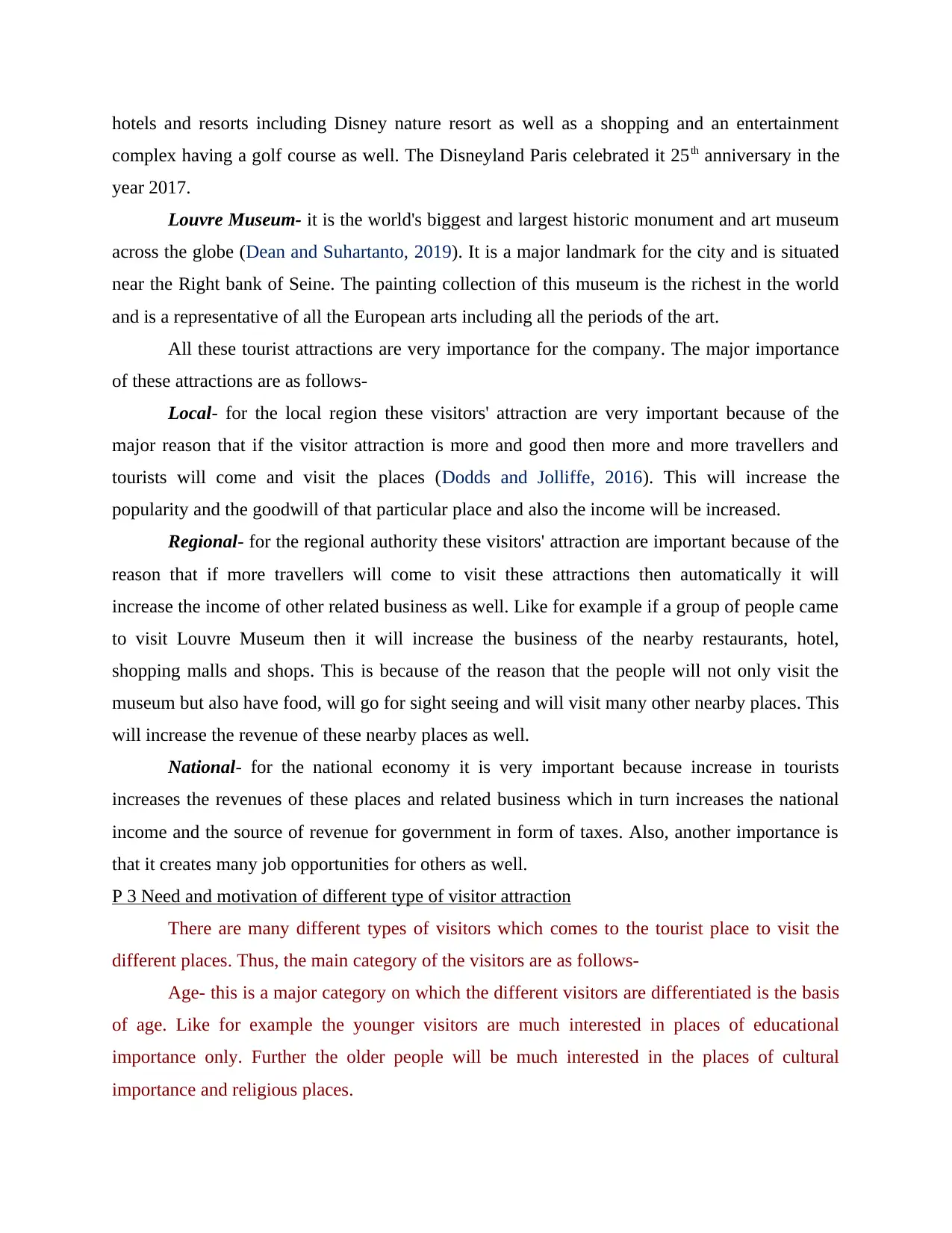
hotels and resorts including Disney nature resort as well as a shopping and an entertainment
complex having a golf course as well. The Disneyland Paris celebrated it 25th anniversary in the
year 2017.
Louvre Museum- it is the world's biggest and largest historic monument and art museum
across the globe (Dean and Suhartanto, 2019). It is a major landmark for the city and is situated
near the Right bank of Seine. The painting collection of this museum is the richest in the world
and is a representative of all the European arts including all the periods of the art.
All these tourist attractions are very importance for the company. The major importance
of these attractions are as follows-
Local- for the local region these visitors' attraction are very important because of the
major reason that if the visitor attraction is more and good then more and more travellers and
tourists will come and visit the places (Dodds and Jolliffe, 2016). This will increase the
popularity and the goodwill of that particular place and also the income will be increased.
Regional- for the regional authority these visitors' attraction are important because of the
reason that if more travellers will come to visit these attractions then automatically it will
increase the income of other related business as well. Like for example if a group of people came
to visit Louvre Museum then it will increase the business of the nearby restaurants, hotel,
shopping malls and shops. This is because of the reason that the people will not only visit the
museum but also have food, will go for sight seeing and will visit many other nearby places. This
will increase the revenue of these nearby places as well.
National- for the national economy it is very important because increase in tourists
increases the revenues of these places and related business which in turn increases the national
income and the source of revenue for government in form of taxes. Also, another importance is
that it creates many job opportunities for others as well.
P 3 Need and motivation of different type of visitor attraction
There are many different types of visitors which comes to the tourist place to visit the
different places. Thus, the main category of the visitors are as follows-
Age- this is a major category on which the different visitors are differentiated is the basis
of age. Like for example the younger visitors are much interested in places of educational
importance only. Further the older people will be much interested in the places of cultural
importance and religious places.
complex having a golf course as well. The Disneyland Paris celebrated it 25th anniversary in the
year 2017.
Louvre Museum- it is the world's biggest and largest historic monument and art museum
across the globe (Dean and Suhartanto, 2019). It is a major landmark for the city and is situated
near the Right bank of Seine. The painting collection of this museum is the richest in the world
and is a representative of all the European arts including all the periods of the art.
All these tourist attractions are very importance for the company. The major importance
of these attractions are as follows-
Local- for the local region these visitors' attraction are very important because of the
major reason that if the visitor attraction is more and good then more and more travellers and
tourists will come and visit the places (Dodds and Jolliffe, 2016). This will increase the
popularity and the goodwill of that particular place and also the income will be increased.
Regional- for the regional authority these visitors' attraction are important because of the
reason that if more travellers will come to visit these attractions then automatically it will
increase the income of other related business as well. Like for example if a group of people came
to visit Louvre Museum then it will increase the business of the nearby restaurants, hotel,
shopping malls and shops. This is because of the reason that the people will not only visit the
museum but also have food, will go for sight seeing and will visit many other nearby places. This
will increase the revenue of these nearby places as well.
National- for the national economy it is very important because increase in tourists
increases the revenues of these places and related business which in turn increases the national
income and the source of revenue for government in form of taxes. Also, another importance is
that it creates many job opportunities for others as well.
P 3 Need and motivation of different type of visitor attraction
There are many different types of visitors which comes to the tourist place to visit the
different places. Thus, the main category of the visitors are as follows-
Age- this is a major category on which the different visitors are differentiated is the basis
of age. Like for example the younger visitors are much interested in places of educational
importance only. Further the older people will be much interested in the places of cultural
importance and religious places.

Income- another different range of visitor is on the basis of the income that is high
income group and low and medium income group of visitors. The high-income group visitors
visits to the expensive destinations for travelling as compared to the low income group.
Need refers to as the requirements or necessities which the person requires or which
influences the person to travel to different types of places of visitors attraction (Lawton, and
Weaver, 2015). The need here also means the need to travel to such places of attraction or the
reasons for which the person needs to travel. Motivation refers to as the principle that guide the
person behaviour in doing something or the force that drives a person to do something. These
places of attraction need to do a proper research of the requirements and reasons behind the
person coming to that place of attraction.
For instance, Disneyland Paris is a place which contains amusements parks and theme
parks so the place must ensure that there are proper ways of entertaining the people and tourist
coming to these places (Russell, Taylor and Aley, 2018). If these basic amenities will not be
made available to the people coming there then they will not e motivated to come again as well.
For providing a good and better visitor experience to them it is necessary to keep the visitor
motivated. The visitor will only be motivated if their basic needs are satisfied that is for what
purpose they have come has been achieved.
Another example, needs for visiting a museum can be to enhance the knowledge of a
person relating to culture, history, art and many other related things. If the museum does not
fulfil this need or motive of the person coming to the museum then they will not be motivated to
come to such place again. So Louvre museum needs to take into consideration all the need of the
people coming to that place.
P 4 Positive and negative impact of different factors on visitor attraction
There are many factors which has influence and impacts on the places of visitors
attractions. The factors which have impact on the different places of attraction are as follows-
Social- these factor includes the taste and preferences of the people coming to travel for
that place and also includes the buying and consumption behaviour of the individual. This can
have both positive and negative impact. For example, the attraction place have only non-
vegetarian food but the people coming are of vegetarian background then it will have a negative
impact on the travellers. Similarly, if the tourist get what it wants then it will have positive
impact. For instance if the traveller has visited to Disney land for amusements and they get
income group and low and medium income group of visitors. The high-income group visitors
visits to the expensive destinations for travelling as compared to the low income group.
Need refers to as the requirements or necessities which the person requires or which
influences the person to travel to different types of places of visitors attraction (Lawton, and
Weaver, 2015). The need here also means the need to travel to such places of attraction or the
reasons for which the person needs to travel. Motivation refers to as the principle that guide the
person behaviour in doing something or the force that drives a person to do something. These
places of attraction need to do a proper research of the requirements and reasons behind the
person coming to that place of attraction.
For instance, Disneyland Paris is a place which contains amusements parks and theme
parks so the place must ensure that there are proper ways of entertaining the people and tourist
coming to these places (Russell, Taylor and Aley, 2018). If these basic amenities will not be
made available to the people coming there then they will not e motivated to come again as well.
For providing a good and better visitor experience to them it is necessary to keep the visitor
motivated. The visitor will only be motivated if their basic needs are satisfied that is for what
purpose they have come has been achieved.
Another example, needs for visiting a museum can be to enhance the knowledge of a
person relating to culture, history, art and many other related things. If the museum does not
fulfil this need or motive of the person coming to the museum then they will not be motivated to
come to such place again. So Louvre museum needs to take into consideration all the need of the
people coming to that place.
P 4 Positive and negative impact of different factors on visitor attraction
There are many factors which has influence and impacts on the places of visitors
attractions. The factors which have impact on the different places of attraction are as follows-
Social- these factor includes the taste and preferences of the people coming to travel for
that place and also includes the buying and consumption behaviour of the individual. This can
have both positive and negative impact. For example, the attraction place have only non-
vegetarian food but the people coming are of vegetarian background then it will have a negative
impact on the travellers. Similarly, if the tourist get what it wants then it will have positive
impact. For instance if the traveller has visited to Disney land for amusements and they get
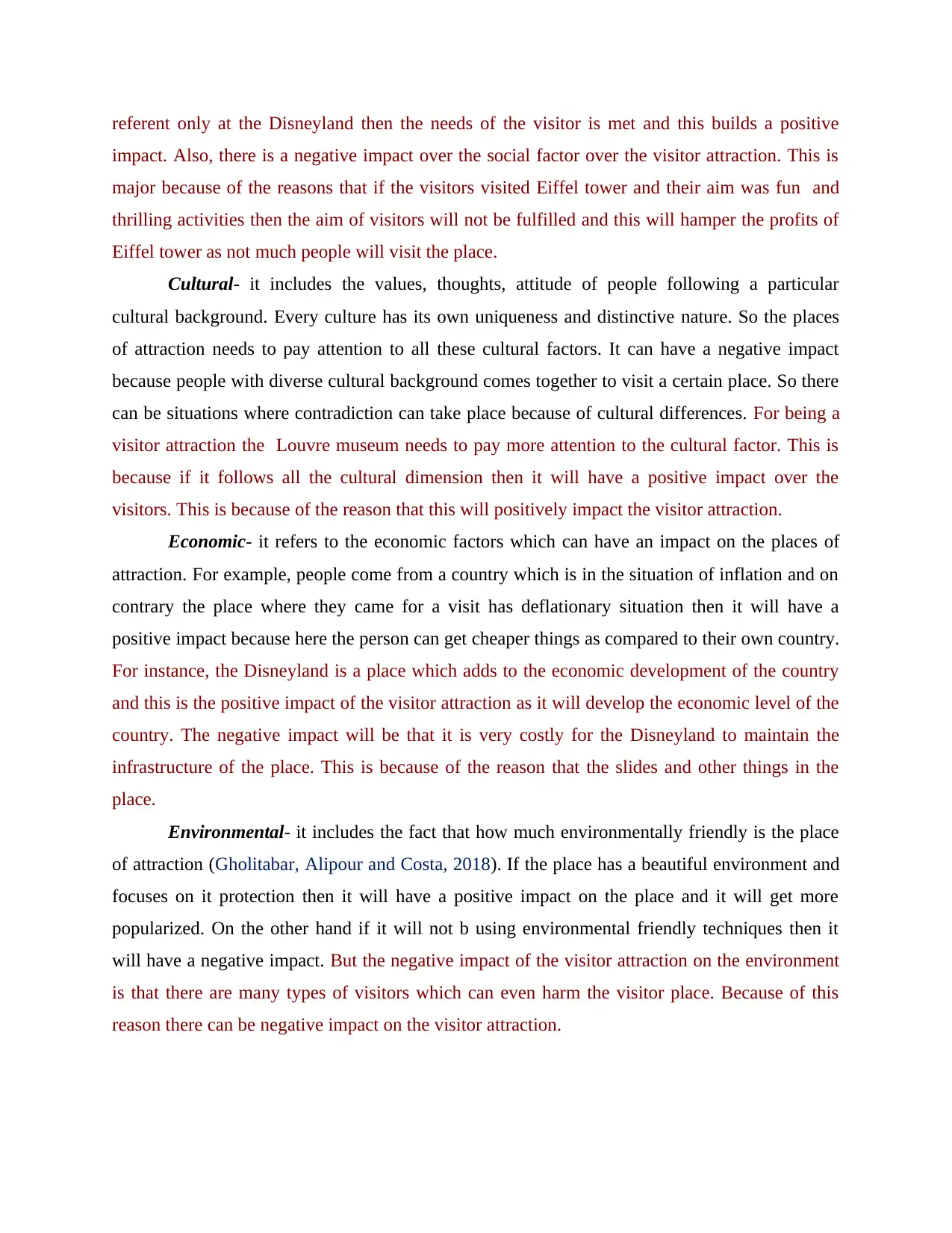
referent only at the Disneyland then the needs of the visitor is met and this builds a positive
impact. Also, there is a negative impact over the social factor over the visitor attraction. This is
major because of the reasons that if the visitors visited Eiffel tower and their aim was fun and
thrilling activities then the aim of visitors will not be fulfilled and this will hamper the profits of
Eiffel tower as not much people will visit the place.
Cultural- it includes the values, thoughts, attitude of people following a particular
cultural background. Every culture has its own uniqueness and distinctive nature. So the places
of attraction needs to pay attention to all these cultural factors. It can have a negative impact
because people with diverse cultural background comes together to visit a certain place. So there
can be situations where contradiction can take place because of cultural differences. For being a
visitor attraction the Louvre museum needs to pay more attention to the cultural factor. This is
because if it follows all the cultural dimension then it will have a positive impact over the
visitors. This is because of the reason that this will positively impact the visitor attraction.
Economic- it refers to the economic factors which can have an impact on the places of
attraction. For example, people come from a country which is in the situation of inflation and on
contrary the place where they came for a visit has deflationary situation then it will have a
positive impact because here the person can get cheaper things as compared to their own country.
For instance, the Disneyland is a place which adds to the economic development of the country
and this is the positive impact of the visitor attraction as it will develop the economic level of the
country. The negative impact will be that it is very costly for the Disneyland to maintain the
infrastructure of the place. This is because of the reason that the slides and other things in the
place.
Environmental- it includes the fact that how much environmentally friendly is the place
of attraction (Gholitabar, Alipour and Costa, 2018). If the place has a beautiful environment and
focuses on it protection then it will have a positive impact on the place and it will get more
popularized. On the other hand if it will not b using environmental friendly techniques then it
will have a negative impact. But the negative impact of the visitor attraction on the environment
is that there are many types of visitors which can even harm the visitor place. Because of this
reason there can be negative impact on the visitor attraction.
impact. Also, there is a negative impact over the social factor over the visitor attraction. This is
major because of the reasons that if the visitors visited Eiffel tower and their aim was fun and
thrilling activities then the aim of visitors will not be fulfilled and this will hamper the profits of
Eiffel tower as not much people will visit the place.
Cultural- it includes the values, thoughts, attitude of people following a particular
cultural background. Every culture has its own uniqueness and distinctive nature. So the places
of attraction needs to pay attention to all these cultural factors. It can have a negative impact
because people with diverse cultural background comes together to visit a certain place. So there
can be situations where contradiction can take place because of cultural differences. For being a
visitor attraction the Louvre museum needs to pay more attention to the cultural factor. This is
because if it follows all the cultural dimension then it will have a positive impact over the
visitors. This is because of the reason that this will positively impact the visitor attraction.
Economic- it refers to the economic factors which can have an impact on the places of
attraction. For example, people come from a country which is in the situation of inflation and on
contrary the place where they came for a visit has deflationary situation then it will have a
positive impact because here the person can get cheaper things as compared to their own country.
For instance, the Disneyland is a place which adds to the economic development of the country
and this is the positive impact of the visitor attraction as it will develop the economic level of the
country. The negative impact will be that it is very costly for the Disneyland to maintain the
infrastructure of the place. This is because of the reason that the slides and other things in the
place.
Environmental- it includes the fact that how much environmentally friendly is the place
of attraction (Gholitabar, Alipour and Costa, 2018). If the place has a beautiful environment and
focuses on it protection then it will have a positive impact on the place and it will get more
popularized. On the other hand if it will not b using environmental friendly techniques then it
will have a negative impact. But the negative impact of the visitor attraction on the environment
is that there are many types of visitors which can even harm the visitor place. Because of this
reason there can be negative impact on the visitor attraction.
Paraphrase This Document
Need a fresh take? Get an instant paraphrase of this document with our AI Paraphraser
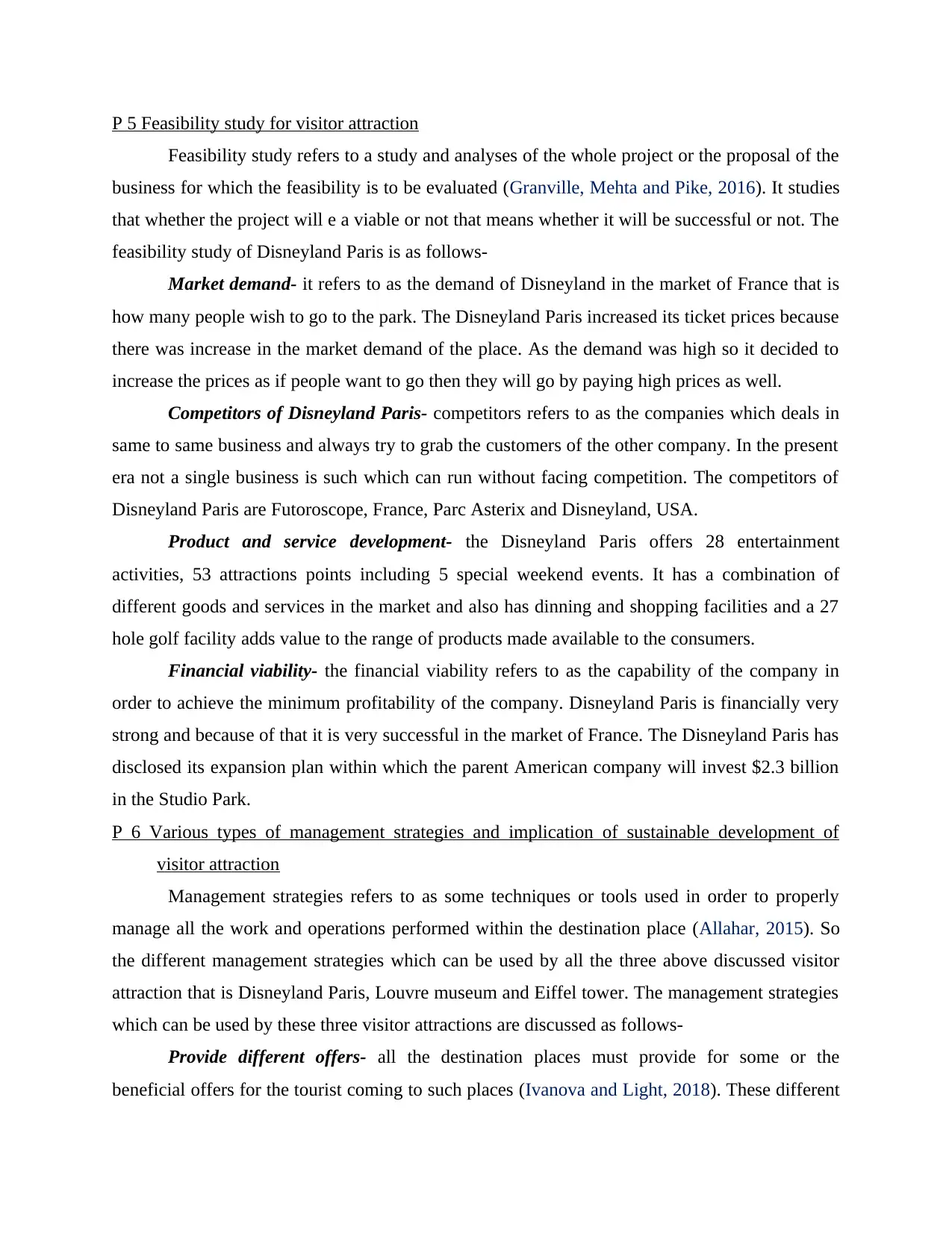
P 5 Feasibility study for visitor attraction
Feasibility study refers to a study and analyses of the whole project or the proposal of the
business for which the feasibility is to be evaluated (Granville, Mehta and Pike, 2016). It studies
that whether the project will e a viable or not that means whether it will be successful or not. The
feasibility study of Disneyland Paris is as follows-
Market demand- it refers to as the demand of Disneyland in the market of France that is
how many people wish to go to the park. The Disneyland Paris increased its ticket prices because
there was increase in the market demand of the place. As the demand was high so it decided to
increase the prices as if people want to go then they will go by paying high prices as well.
Competitors of Disneyland Paris- competitors refers to as the companies which deals in
same to same business and always try to grab the customers of the other company. In the present
era not a single business is such which can run without facing competition. The competitors of
Disneyland Paris are Futoroscope, France, Parc Asterix and Disneyland, USA.
Product and service development- the Disneyland Paris offers 28 entertainment
activities, 53 attractions points including 5 special weekend events. It has a combination of
different goods and services in the market and also has dinning and shopping facilities and a 27
hole golf facility adds value to the range of products made available to the consumers.
Financial viability- the financial viability refers to as the capability of the company in
order to achieve the minimum profitability of the company. Disneyland Paris is financially very
strong and because of that it is very successful in the market of France. The Disneyland Paris has
disclosed its expansion plan within which the parent American company will invest $2.3 billion
in the Studio Park.
P 6 Various types of management strategies and implication of sustainable development of
visitor attraction
Management strategies refers to as some techniques or tools used in order to properly
manage all the work and operations performed within the destination place (Allahar, 2015). So
the different management strategies which can be used by all the three above discussed visitor
attraction that is Disneyland Paris, Louvre museum and Eiffel tower. The management strategies
which can be used by these three visitor attractions are discussed as follows-
Provide different offers- all the destination places must provide for some or the
beneficial offers for the tourist coming to such places (Ivanova and Light, 2018). These different
Feasibility study refers to a study and analyses of the whole project or the proposal of the
business for which the feasibility is to be evaluated (Granville, Mehta and Pike, 2016). It studies
that whether the project will e a viable or not that means whether it will be successful or not. The
feasibility study of Disneyland Paris is as follows-
Market demand- it refers to as the demand of Disneyland in the market of France that is
how many people wish to go to the park. The Disneyland Paris increased its ticket prices because
there was increase in the market demand of the place. As the demand was high so it decided to
increase the prices as if people want to go then they will go by paying high prices as well.
Competitors of Disneyland Paris- competitors refers to as the companies which deals in
same to same business and always try to grab the customers of the other company. In the present
era not a single business is such which can run without facing competition. The competitors of
Disneyland Paris are Futoroscope, France, Parc Asterix and Disneyland, USA.
Product and service development- the Disneyland Paris offers 28 entertainment
activities, 53 attractions points including 5 special weekend events. It has a combination of
different goods and services in the market and also has dinning and shopping facilities and a 27
hole golf facility adds value to the range of products made available to the consumers.
Financial viability- the financial viability refers to as the capability of the company in
order to achieve the minimum profitability of the company. Disneyland Paris is financially very
strong and because of that it is very successful in the market of France. The Disneyland Paris has
disclosed its expansion plan within which the parent American company will invest $2.3 billion
in the Studio Park.
P 6 Various types of management strategies and implication of sustainable development of
visitor attraction
Management strategies refers to as some techniques or tools used in order to properly
manage all the work and operations performed within the destination place (Allahar, 2015). So
the different management strategies which can be used by all the three above discussed visitor
attraction that is Disneyland Paris, Louvre museum and Eiffel tower. The management strategies
which can be used by these three visitor attractions are discussed as follows-
Provide different offers- all the destination places must provide for some or the
beneficial offers for the tourist coming to such places (Ivanova and Light, 2018). These different
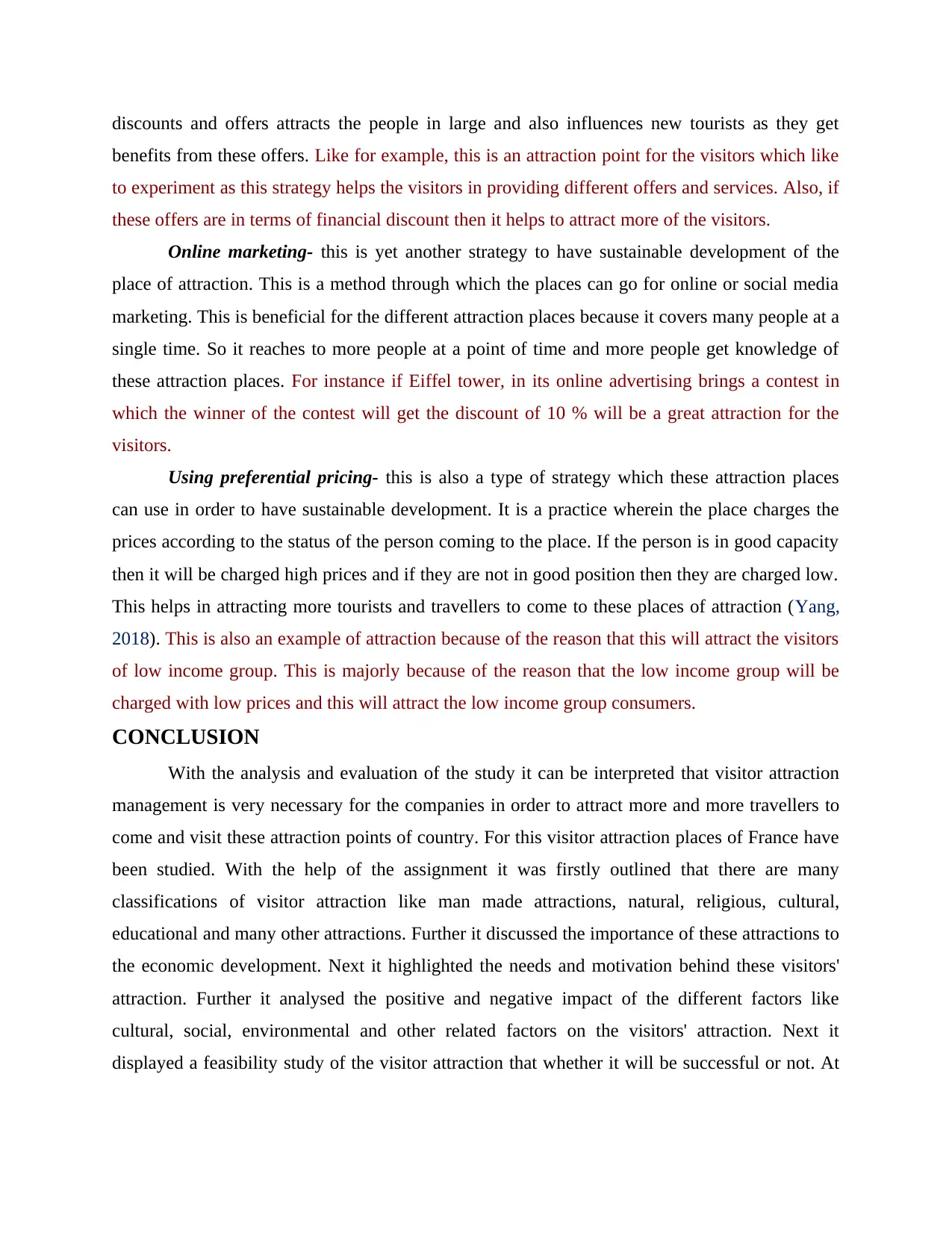
discounts and offers attracts the people in large and also influences new tourists as they get
benefits from these offers. Like for example, this is an attraction point for the visitors which like
to experiment as this strategy helps the visitors in providing different offers and services. Also, if
these offers are in terms of financial discount then it helps to attract more of the visitors.
Online marketing- this is yet another strategy to have sustainable development of the
place of attraction. This is a method through which the places can go for online or social media
marketing. This is beneficial for the different attraction places because it covers many people at a
single time. So it reaches to more people at a point of time and more people get knowledge of
these attraction places. For instance if Eiffel tower, in its online advertising brings a contest in
which the winner of the contest will get the discount of 10 % will be a great attraction for the
visitors.
Using preferential pricing- this is also a type of strategy which these attraction places
can use in order to have sustainable development. It is a practice wherein the place charges the
prices according to the status of the person coming to the place. If the person is in good capacity
then it will be charged high prices and if they are not in good position then they are charged low.
This helps in attracting more tourists and travellers to come to these places of attraction (Yang,
2018). This is also an example of attraction because of the reason that this will attract the visitors
of low income group. This is majorly because of the reason that the low income group will be
charged with low prices and this will attract the low income group consumers.
CONCLUSION
With the analysis and evaluation of the study it can be interpreted that visitor attraction
management is very necessary for the companies in order to attract more and more travellers to
come and visit these attraction points of country. For this visitor attraction places of France have
been studied. With the help of the assignment it was firstly outlined that there are many
classifications of visitor attraction like man made attractions, natural, religious, cultural,
educational and many other attractions. Further it discussed the importance of these attractions to
the economic development. Next it highlighted the needs and motivation behind these visitors'
attraction. Further it analysed the positive and negative impact of the different factors like
cultural, social, environmental and other related factors on the visitors' attraction. Next it
displayed a feasibility study of the visitor attraction that whether it will be successful or not. At
benefits from these offers. Like for example, this is an attraction point for the visitors which like
to experiment as this strategy helps the visitors in providing different offers and services. Also, if
these offers are in terms of financial discount then it helps to attract more of the visitors.
Online marketing- this is yet another strategy to have sustainable development of the
place of attraction. This is a method through which the places can go for online or social media
marketing. This is beneficial for the different attraction places because it covers many people at a
single time. So it reaches to more people at a point of time and more people get knowledge of
these attraction places. For instance if Eiffel tower, in its online advertising brings a contest in
which the winner of the contest will get the discount of 10 % will be a great attraction for the
visitors.
Using preferential pricing- this is also a type of strategy which these attraction places
can use in order to have sustainable development. It is a practice wherein the place charges the
prices according to the status of the person coming to the place. If the person is in good capacity
then it will be charged high prices and if they are not in good position then they are charged low.
This helps in attracting more tourists and travellers to come to these places of attraction (Yang,
2018). This is also an example of attraction because of the reason that this will attract the visitors
of low income group. This is majorly because of the reason that the low income group will be
charged with low prices and this will attract the low income group consumers.
CONCLUSION
With the analysis and evaluation of the study it can be interpreted that visitor attraction
management is very necessary for the companies in order to attract more and more travellers to
come and visit these attraction points of country. For this visitor attraction places of France have
been studied. With the help of the assignment it was firstly outlined that there are many
classifications of visitor attraction like man made attractions, natural, religious, cultural,
educational and many other attractions. Further it discussed the importance of these attractions to
the economic development. Next it highlighted the needs and motivation behind these visitors'
attraction. Further it analysed the positive and negative impact of the different factors like
cultural, social, environmental and other related factors on the visitors' attraction. Next it
displayed a feasibility study of the visitor attraction that whether it will be successful or not. At

last it discussed some different types of strategies for management in order to have sustainable
development for the visitor attractions.
development for the visitor attractions.
Secure Best Marks with AI Grader
Need help grading? Try our AI Grader for instant feedback on your assignments.
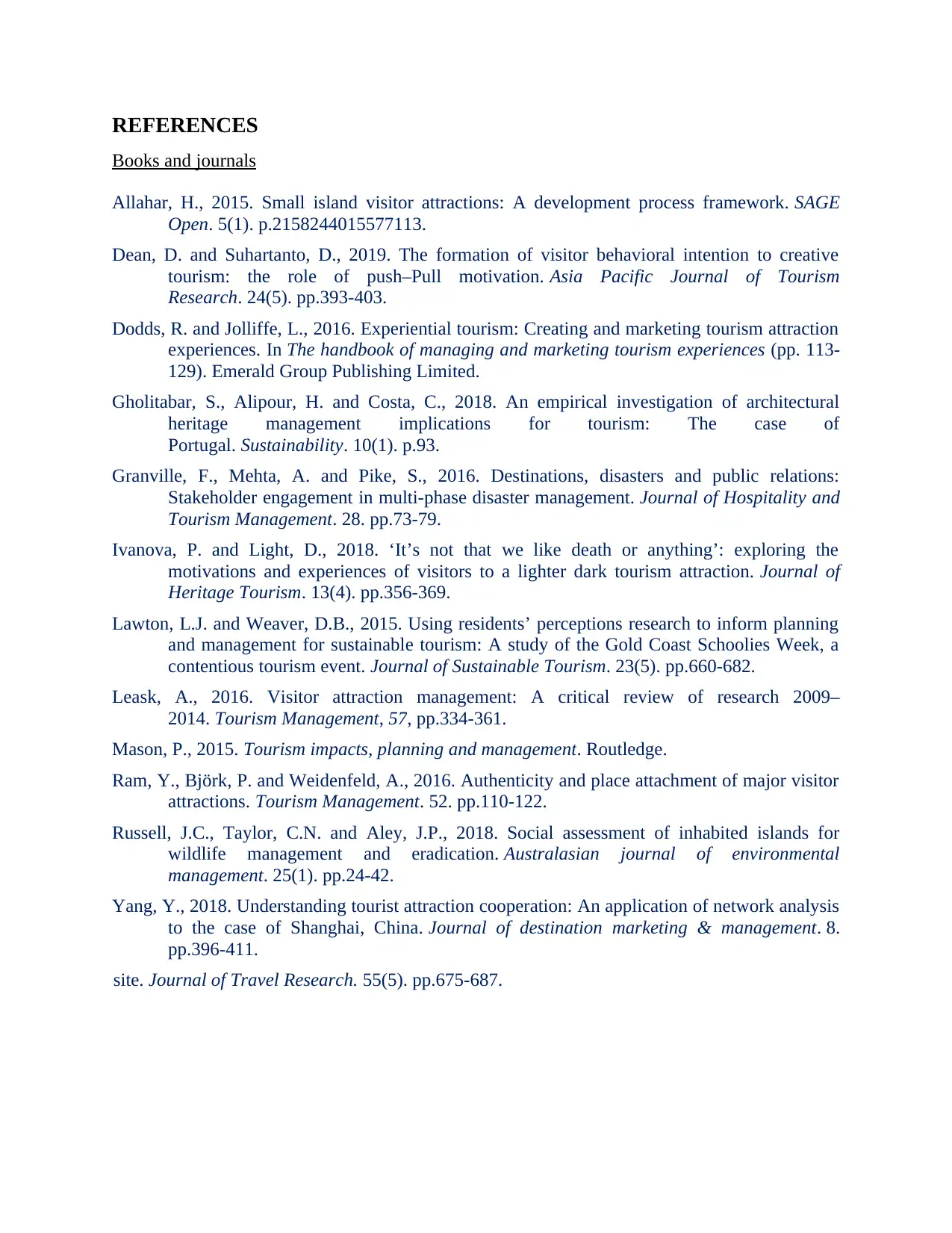
REFERENCES
Books and journals
Allahar, H., 2015. Small island visitor attractions: A development process framework. SAGE
Open. 5(1). p.2158244015577113.
Dean, D. and Suhartanto, D., 2019. The formation of visitor behavioral intention to creative
tourism: the role of push–Pull motivation. Asia Pacific Journal of Tourism
Research. 24(5). pp.393-403.
Dodds, R. and Jolliffe, L., 2016. Experiential tourism: Creating and marketing tourism attraction
experiences. In The handbook of managing and marketing tourism experiences (pp. 113-
129). Emerald Group Publishing Limited.
Gholitabar, S., Alipour, H. and Costa, C., 2018. An empirical investigation of architectural
heritage management implications for tourism: The case of
Portugal. Sustainability. 10(1). p.93.
Granville, F., Mehta, A. and Pike, S., 2016. Destinations, disasters and public relations:
Stakeholder engagement in multi-phase disaster management. Journal of Hospitality and
Tourism Management. 28. pp.73-79.
Ivanova, P. and Light, D., 2018. ‘It’s not that we like death or anything’: exploring the
motivations and experiences of visitors to a lighter dark tourism attraction. Journal of
Heritage Tourism. 13(4). pp.356-369.
Lawton, L.J. and Weaver, D.B., 2015. Using residents’ perceptions research to inform planning
and management for sustainable tourism: A study of the Gold Coast Schoolies Week, a
contentious tourism event. Journal of Sustainable Tourism. 23(5). pp.660-682.
Leask, A., 2016. Visitor attraction management: A critical review of research 2009–
2014. Tourism Management, 57, pp.334-361.
Mason, P., 2015. Tourism impacts, planning and management. Routledge.
Ram, Y., Björk, P. and Weidenfeld, A., 2016. Authenticity and place attachment of major visitor
attractions. Tourism Management. 52. pp.110-122.
Russell, J.C., Taylor, C.N. and Aley, J.P., 2018. Social assessment of inhabited islands for
wildlife management and eradication. Australasian journal of environmental
management. 25(1). pp.24-42.
Yang, Y., 2018. Understanding tourist attraction cooperation: An application of network analysis
to the case of Shanghai, China. Journal of destination marketing & management. 8.
pp.396-411.
site. Journal of Travel Research. 55(5). pp.675-687.
Books and journals
Allahar, H., 2015. Small island visitor attractions: A development process framework. SAGE
Open. 5(1). p.2158244015577113.
Dean, D. and Suhartanto, D., 2019. The formation of visitor behavioral intention to creative
tourism: the role of push–Pull motivation. Asia Pacific Journal of Tourism
Research. 24(5). pp.393-403.
Dodds, R. and Jolliffe, L., 2016. Experiential tourism: Creating and marketing tourism attraction
experiences. In The handbook of managing and marketing tourism experiences (pp. 113-
129). Emerald Group Publishing Limited.
Gholitabar, S., Alipour, H. and Costa, C., 2018. An empirical investigation of architectural
heritage management implications for tourism: The case of
Portugal. Sustainability. 10(1). p.93.
Granville, F., Mehta, A. and Pike, S., 2016. Destinations, disasters and public relations:
Stakeholder engagement in multi-phase disaster management. Journal of Hospitality and
Tourism Management. 28. pp.73-79.
Ivanova, P. and Light, D., 2018. ‘It’s not that we like death or anything’: exploring the
motivations and experiences of visitors to a lighter dark tourism attraction. Journal of
Heritage Tourism. 13(4). pp.356-369.
Lawton, L.J. and Weaver, D.B., 2015. Using residents’ perceptions research to inform planning
and management for sustainable tourism: A study of the Gold Coast Schoolies Week, a
contentious tourism event. Journal of Sustainable Tourism. 23(5). pp.660-682.
Leask, A., 2016. Visitor attraction management: A critical review of research 2009–
2014. Tourism Management, 57, pp.334-361.
Mason, P., 2015. Tourism impacts, planning and management. Routledge.
Ram, Y., Björk, P. and Weidenfeld, A., 2016. Authenticity and place attachment of major visitor
attractions. Tourism Management. 52. pp.110-122.
Russell, J.C., Taylor, C.N. and Aley, J.P., 2018. Social assessment of inhabited islands for
wildlife management and eradication. Australasian journal of environmental
management. 25(1). pp.24-42.
Yang, Y., 2018. Understanding tourist attraction cooperation: An application of network analysis
to the case of Shanghai, China. Journal of destination marketing & management. 8.
pp.396-411.
site. Journal of Travel Research. 55(5). pp.675-687.
1 out of 11
Related Documents
Your All-in-One AI-Powered Toolkit for Academic Success.
+13062052269
info@desklib.com
Available 24*7 on WhatsApp / Email
![[object Object]](/_next/static/media/star-bottom.7253800d.svg)
Unlock your academic potential
© 2024 | Zucol Services PVT LTD | All rights reserved.





